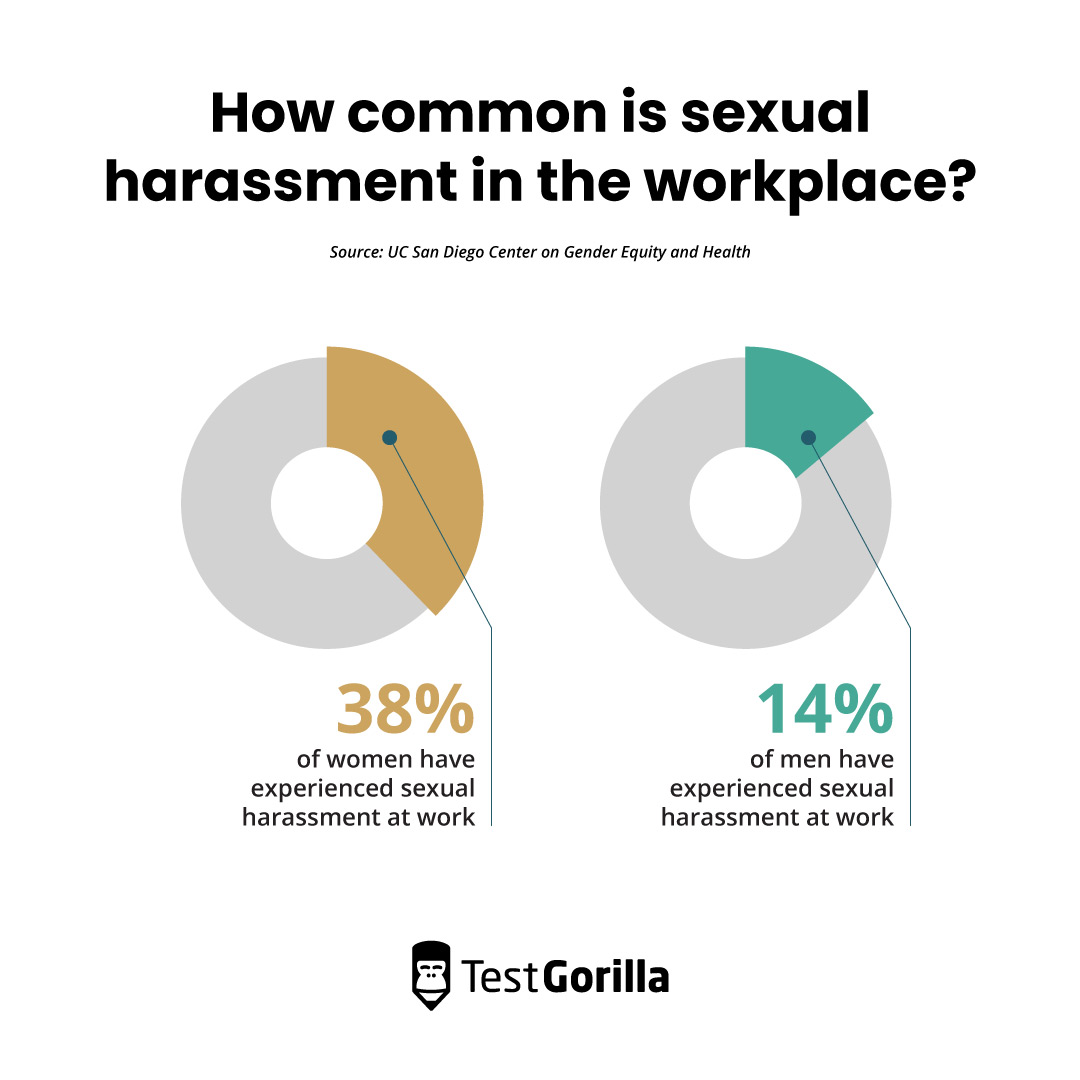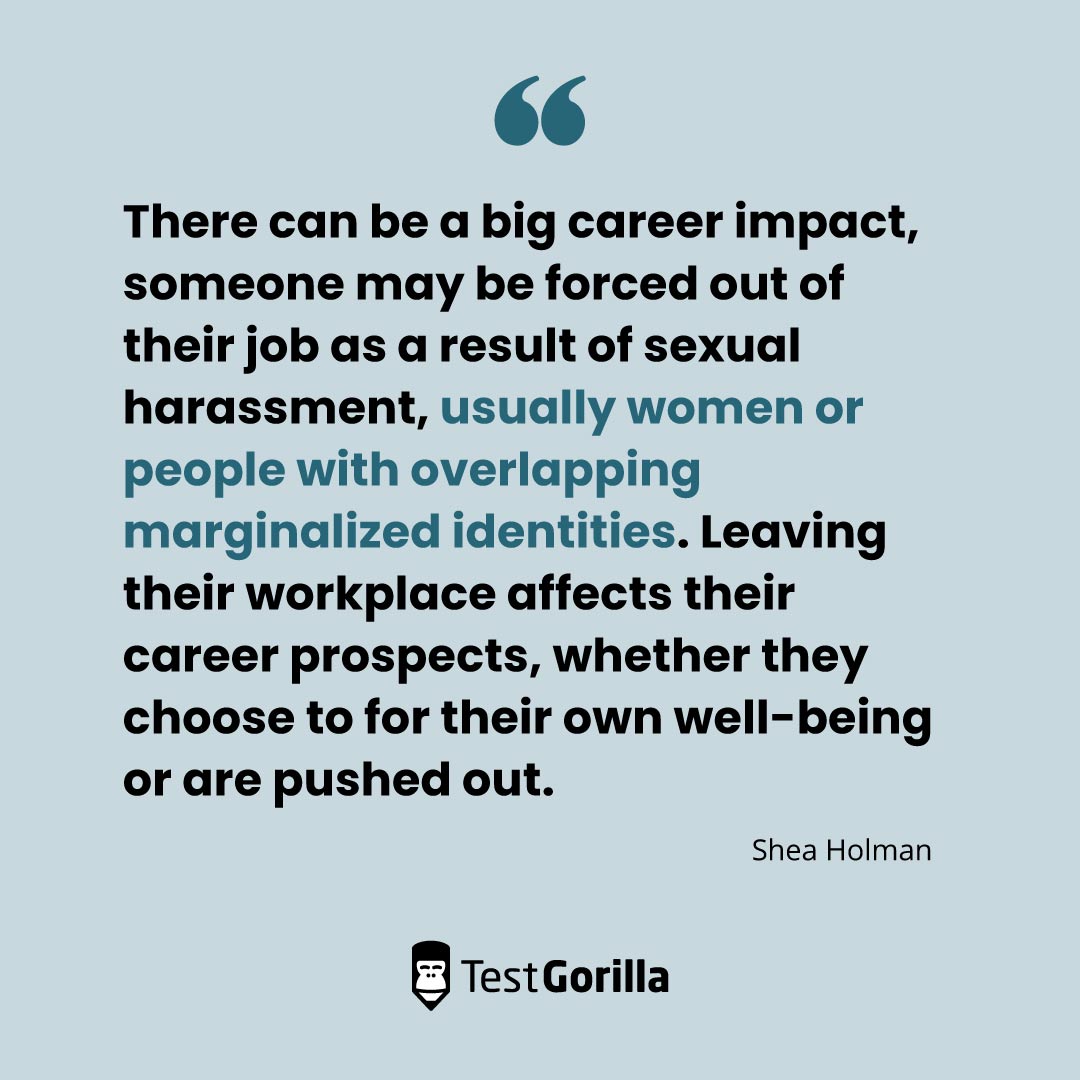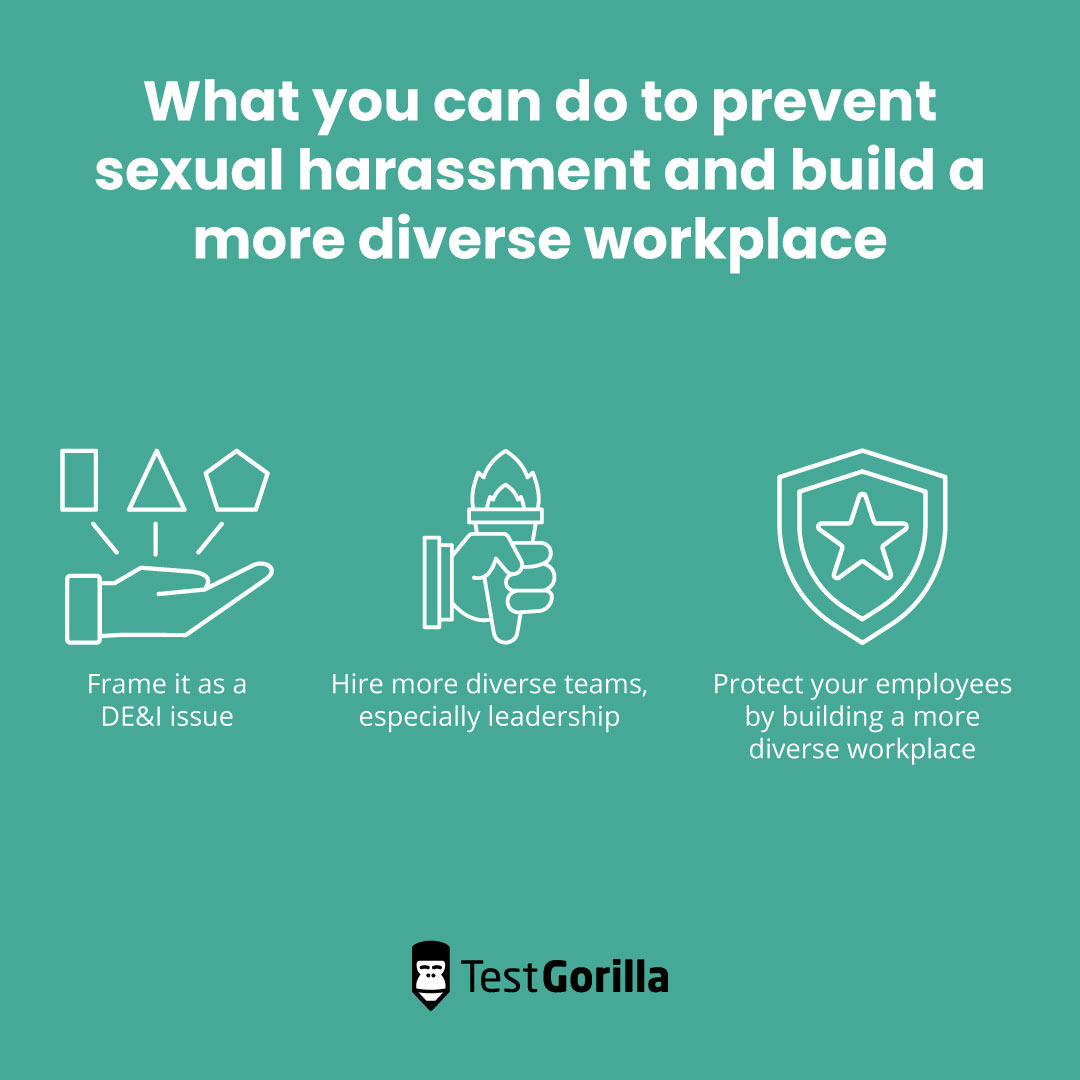No matter how well you think your organization deals with sexual misconduct, measures like regular training and strict policies may not be enough to prevent it. Anything from inappropriate workplace relationships to crude jokes can create a hostile work environment where your employees don’t feel comfortable, which is why it’s essential to start at the root of the issue – the inclusiveness of your company.
This is because sexual harassment is ultimately a DE&I issue, with these incidents disproportionately affecting individuals from underrepresented groups, especially when they have overlapping marginalized identities.[1]
In this article, we’ll discuss how common sexual harassment actually is, what it entails, its impact on employees and organizations, and why it’s important to see it from a DE&I lens.
We consulted Shea Holman, counsel and chief operating officer at The Purple Method, an organization dedicated to addressing and preventing sexual misconduct. Here, she shares her insights on the impact of sexual harassment and why you should frame it as a DE&I issue.
How common is sexual harassment in the workplace?
A study conducted in the wake of the #MeToo movement found that 38% of women and 14% of men have experienced sexual harassment at work.[2] While over a third of all women have been victims of workplace sexual harassment in their lifetime, people with overlapping marginalized identities (especially women and nonbinary folks) are affected even more often.[1]
However, someone’s understanding of sexual harassment influences whether they think they’ve been a victim of it. This is why in a well-known survey conducted by the Equal Employment Opportunities Commission (EEOC), between 25% and 85% of women reported having experienced workplace sexual harassment.
The range is so large because when no definition was given for sexual harassment, one in four respondents said they had experienced it. On the flip side, when respondents were given specific examples of what sexual harassment could encompass, the percentage of those affected shot up.
Defining sexual harassment
According to the EEOC, sexual harassment is a form of sexual discrimination that falls under Title VII of the Civil Rights Act.[3]
Shea Holman outlines that there are two branches of sexual misconduct:
Quid pro quo entails someone in a position of authority requesting or demanding sexual favors in exchange for some benefit or to avoid some consequence.
A hostile work environment occurs when unwanted behaviors are severe or pervasive enough that they create an environment someone is no longer comfortable working in.
While many people are familiar with the stereotypical “quid pro quo” form of sexual harassment, that’s not typically how it manifests in the workplace. Something as seemingly harmless as a recurring joke or comments in passing can actually make employees feel extremely uncomfortable and qualify as sexual harassment.
According to Shea, sexual misconduct can encompass a variety of acts, including: gender identity and sexual orientation discrimination, abusive conduct, implicit bias, alcohol usage, dating in the workplace, unwanted compliments, and even jokes.
The best insights on HR and recruitment, delivered to your inbox.
Biweekly updates. No spam. Unsubscribe any time.
What’s the impact of sexual harassment at work?
The EEOC received almost 27,291 charges of sexual harassment between 2018 and 2021, with women filing about 80% of all charges. Sexual harassment is pervasive, and it has lasting negative impacts, both on employees and organizations.
Impact on employees
For employees, sexual harassment has far-reaching consequences, including psychological, physical, and financial impacts.[4] The Purple Method warns that physical symptoms can include headaches, stomach problems, and other stress-induced ailments, including chronic health issues like high blood pressure and heart problems.
On the psychological and emotional side of things, the organization underlines that “sexual harassment is associated with increased risk of anxiety, depression, and post-traumatic stress disorder, as well as diminished self-esteem, self-confidence, and psychological well-being.”
Shea also warns that “if an employee brings a lawsuit against their employer, they have to constantly relive that experience over and over again. Now it becomes compound trauma.”
One of the less obvious consequences of this issue is how it impacts victims’ financial situations and careers. To start, the distress that sexual harassment causes employees can lead to lower productivity, a decline in job performance, and even lost wages.[4]
“There can be a big career impact,” Shea says. “Someone may be forced out of their job as a result of sexual harassment, usually women or people with overlapping marginalized identities. Leaving their workplace affects their career prospects, whether they choose to for their own well-being or are pushed out.”
For example, if an employee leaves their organization as a result of sexual harassment, they may not be able to get a recommendation from that employer. If they signed a non-disclosure agreement, they may not be allowed to disclose to potential employers why they left their former company.
Between unemployment due to having to leave their company, the loss of valuable benefits, and perhaps even a forced career change, being a victim of workplace sexual harassment can end up costing a victim over a million dollars across their lifetime.[5]
Impact on companies
Sexual harassment doesn’t just hurt victims – it can have extremely negative consequences for organizations. To begin, there are a number of direct financial effects from sexual misconduct:
Loss of worker productivity
Cost to replace employees who leave as a result of sexual harassment
Legal fees and compensation costs
One study found that workplace sexual harassment has a significant negative impact on a company’s future stock performance and profitability. This is in part because an incident can have a lasting impact on an organization's reputation.
Consumers vote with their money, and when it comes to sexual harassment allegations, they aren’t afraid to show their opinions. After Kate Upton accused Guess co-founder Paul Marciano of sexual harassment, the brand’s shares fell almost 18%. When casino mogul Steve Wynn was accused of sexual assault, shares of his resort company dropped, causing a loss of $3.5 billion in company value.[6]
“It is in employers' best interest to take sexual harassment seriously, not just because it’s the right thing to do – it’s good for business,” Shea says. “Companies that address sexual harassment and create a safer workplace have better creativity and are more likely to outperform their peers.”
Why workplace sexual harassment is a DE&I issue
A 2021 study found that while at least 40% of women surveyed had experienced workplace harassment, women with marginalized identities (for example, related to race or disability) were at an increased risk of experiencing sexual harassment at work.[7] Ethnic minority workers, men and women alike, also reported higher rates of sexual harassment than White workers.
Additionally, almost seven in 10 LGBTQ+ workers had experienced some form of workplace harassment, and over two thirds of disabled women reported being sexually harassed at work.
Your marginalized workers, especially employees with overlapping identities, are at a greater risk of falling victim to workplace harassment, especially of a sexual nature. This is why you need to see harassment as more than just a gender issue: It’s a DE&I problem.
What can you do to prevent sexual harassment and build a more diverse workplace?
Aside from taking general steps to combat sexual harassment in the workplace, seeing it as a DE&I issue and taking initiatives to build a more inclusive organization can help you prevent incidents from happening. Here’s how:
Frame it as a DE&I issue
Once you know sexual harassment is really a DE&I issue at its root, treating it as such can help prevent it. “Be aware that intersectionality is at play here,” Shea says. “Ask yourself, how are we amplifying the voices of those who are more marginalized? Are we doing employee climate surveys? Do marginalized employees feel they can speak up?”
In some cases, sexual harassment is a form of workplace bullying, which often disproportionately affects individuals with overlapping marginalized identities. For this reason, embedding DE&I initiatives into the fiber of your organization can play a big role in reducing sexual harassment.
When your people are more aware of their privilege and biases, they’re less likely to act in a way that creates an uncomfortable or hostile environment for their coworkers. Thus, it’s crucial to run regular implicit bias training, and more importantly, build a diverse team.
Hire more diverse teams, especially leadership
Because DE&I can play such a big role in preventing workplace sexual harassment, hiring a diverse team is essential to creating a safe workplace. Use talent assessments in your hiring process instead of relying on resumes, experience, connections, or where a candidate went to school, all of which are susceptible to unconscious bias.
Our research found that 91% of organizations that use skills-based hiring saw an increase in workplace diversity. Therefore, if you want to avoid creating a workplace that’s hostile to women and minority groups, implement talent assessments when recruiting new candidates.
This is especially important when building out your leadership team. Upper management is an area where hiring women and minorities can have an extremely positive impact, as doing so creates a more inclusive environment from the top down. It also ensures you have leaders who can advocate for other women and individuals from marginalized groups, who are more likely to be victims of sexual harassment.
Protect your employees by building a more diverse workplace
It’s no one’s favorite topic, but we need to be talking about how to prevent sexual harassment if we want to create safer workplaces. For example, you should take proactive measures toward minimizing sexual misconduct in your organization, like making it easy for employees to report incidents and having strict disciplinary policies.
However, preventing workplace sexual harassment really starts at the root: building a diverse and inclusive workplace where all your employees feel comfortable and valued.
To do so, implement skills-based hiring, which will help you develop an organization with employees from a range of backgrounds and identities. By eliminating biases from your hiring process and placing more emphasis on candidates’ skills, you can create an environment where all your employees – regardless of gender, sexual identity, race, or ethnicity – feel safe, valued, and heard.
Build a safer, more inclusive organization. Skills-based hiring helps you hire employees from all backgrounds, making your workplace more inclusive. Download the 2022 State of Skills-Based Hiring report to learn more |
Sources
“Remote work since Covid-19 is exacerbating harm. What companies need to know and do.” (2021). Project Include. Retrieved August 3, 2023. https://projectinclude.org/assets/pdf/Project-Include-Harassment-Report-0321-F3.pdf
“Measuring #MeToo: A National Study on Sexual Harassment and Assault.” (2019). UC San Diego Center on Gender Equity and Health. Retrieved August 3, 2023. https://gehweb.ucsd.edu/wp-content/uploads/2019/05/2019-metoo-national-sexual-harassment-and-assault-report.pdf
“Fact Sheet: Sexual Harassment Discrimination.” (1997). U.S. Equal Employment Opportunity Commission. Retrieved August 3, 2023. https://www.eeoc.gov/laws/guidance/fact-sheet-sexual-harassment-discrimination
“‘I Realized that I couldn’t Act Normal’: a Qualitative Study of Sexual Assault Survivors’ Experiences of Workplace Disclosure.” (2022). Journal of Family Violence. Retrieved August 3, 2023. https://link.springer.com/article/10.1007/s10896-020-00183-z
“Paying Today and Tomorrow: Charting the Financial Costs of Workplace Sexual Harassment.” (2021). TIME’S UP Foundation. Retrieved August 3, 2023. https://timesupfoundation.org/wp-content/uploads/2021/07/Paying-Today-and-Tomorrow_Charting-the-Financial-Costs-of-Workplace-Sexual-Harassment_FINAL.pdf
“Companies Are Losing Millions After #MeToo Allegations Like Kate Upton's Claim Against Guess' Paul Marciano.” (2018). TIME. Retrieved August 3, 2023. https://time.com/5130340/kate-upton-guess-stock-price/
“Tackling Sexual Harassment in the Workplace: Recommendations for Employers.” (2021). The Fawcett Society. Retrieved August 3, 2023. https://www.fawcettsociety.org.uk/tackling-sexual-harassment-in-the-workplace#:~:text=Ethnic%20minority%20workers%20
You've scrolled this far
Why not try TestGorilla for free, and see what happens when you put skills first.





















